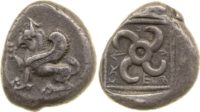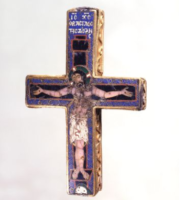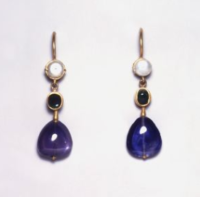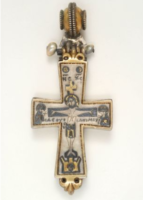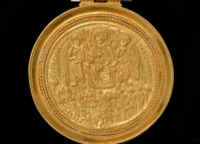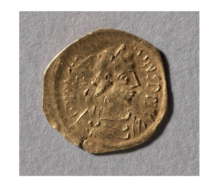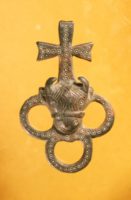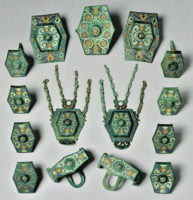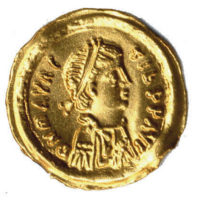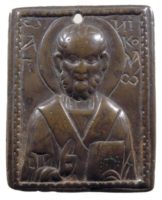Silver coin of Alexander the Great; Greek; Date: 323BC-280BC; Kingdom of Macedonia, Minted in: Anatolia, Turkey (Uncertain mint, Western Asia Minor) Weight: 4.12 grammes. Die-axis: 12 o’clock. British Museum is closed 24, 25 and 26 December and 1 January, but is open every other day of the year. Fast facts about the British Museum: Founded: 1753, Collection size: 8 million objects, Oldest object in the collection: Stone chopping tool (nearly 2 million years old).
Silver Coin, Period: 5th. century B.C. 480BC-460BC (circa). Minted in Lycia, Anatolia, Modern Turkey. Ruler: Taththivaibi Museum Description: “(obverse) Griffin, curved wing, seated left; right forepaw raised. (reverse) Tetraskeles left; in dotted incuse square.” British Museum is closed 24, 25 and 26 December and 1 January, but is open every other day of the year. Fast facts about the British Museum: Founded: 1753, Collection size: 8 million objects, Oldest object in the collection: Stone chopping tool (nearly 2 million years old).
Reliquary Cross with the Crucifixion, Period: Late Byzantine, circa: Late 12th-early 13th century. Materials: enamel on gold. The museum is open to the public Tuesday through Sunday, 11:30 a.m.–5:30 p.m., except for federal holidays.
Ivory Panel, Period: Early Byzantine, circa: 6th c. Made in: Syria. Dimensions: Height: 16.3 centimetres Width: 8.1 centimetres Depth: 1 centimetres Weight: 128 grammes. Carved in relief with a depiction of The Baptism: young Christ standing full face up to waist in water; to left, St John the Baptist stands leaning forward upon a rock, one hand resting upon Christ’s head. British Museum is closed 24, 25 and 26 December and 1 January, but is open every other day of the year. Fast facts about the British Museum: Founded: 1753, Collection size: 8 million objects, Oldest object in the collection: Stone chopping tool (nearly 2 million years old).
Gold coin. Ruler: Tiberius III, Byzantine Emperor; Period: Middle Byzantine; circa: 705-711; Minted in: Ravenna, Italy. British Museum is closed 24, 25 and 26 December and 1 January, but is open every other day of the year. Fast facts about the British Museum: Founded: 1753, Collection size: 8 million objects, Oldest object in the collection: Stone chopping tool (nearly 2 million years old).
Ivory Plaque with Enthroned Mother of God, (“The Stroganoff Ivory”), Period: Middle Byzantine, circa: 950-1025. Material: ivory. The Cleveland Art Museum Hours: Tuesdays, Thursdays, Saturdays, Sundays 10:00 a.m.–5:00 p.m. Wednesdays, Fridays 10:00 a.m.–9:00 p.m. Closed Mondays.
Pair of Earrings. Materials: Pearls, Emeralds, Sapphires, Gold and Gems. Period: Early Byzantine, circa: early 5th century. The museum is open to the public Tuesday through Sunday, 11:30 a.m.–5:30 p.m., except for federal holidays.
Portrait of an official, Period: Early Byzantine Period, circa: Late 5th–early 6th century A.D. Dimensions: Height: 21 cm (8 1/4 in.). Material: Marble. Found: Göktepe near Aphrodisias Ancient City, Anatolia (Modern Turkey). The MFA is open 7 days a week. Monday and Tuesday 10 am–5 pm, Wednesday–Friday 10 am–10 pm, Saturday and Sunday 10 am–5 pm.
Roundel with Emperor John II Comnenus. Period: Byzantine, ca. 1110 – 1118. Material: marble. The museum is open to the public Tuesday through Sunday, 11:30 a.m.–5:30 p.m., except for federal holidays.
Enkolpion Reliquary Cross with Crucifixion and the Virgin, Period: Middle Byzantine, circa 10th to 11th Century A.D. The museum is open to the public Tuesday through Sunday, 11:30 a.m.–5:30 p.m., except for federal holidays.
Enkolpion with Enthroned Virgin, Nativity, Adoration and Baptism, Period: Early Byzantine, circa: Last quarter 6th century (ca. 583). Materials: gold. The museum is open to the public Tuesday through Sunday, 11:30 a.m.–5:30 p.m., except for federal holidays.
Half Tremissis of Justinian I, 527-565, Minted in: Constantinople. Material: Gold. Diameter: w. 1.5 cm (9/16 in.). Cleveland Art Museum Hours: Tuesdays, Thursdays, Saturdays, Sundays 10:00 a.m.–5:00 p.m. Wednesdays, Fridays 10:00 a.m.–9:00 p.m. Closed Mondays.
Loop earring; Materials: silver; Period: Middle Byzantine: 10thc-11thc. Length: 51 millimetres Weight: 12.2 grammes. British Museum is closed 24, 25 and 26 December and 1 January, but is open every other day of the year. Fast facts about the British Museum: Founded: 1753, Collection size: 8 million objects, Oldest object in the collection: Stone chopping tool (nearly 2 million years old).
Sapphire and Tourmaline Ring Gems; Period: Early Byzantine, circa: 6-7th century. Findspot/Location: Constantinople. Materials: Sapphire, Tourmaline. In the Istanbul Archaeological Museum collections, there are rich and very important works of art belonging to various civilizations from the regions from Africa to Balkans , from Anatolia and Mesopotamia to Arab Peninsula and Afghanistan that were in the borders of the Ottoman Empire.
Harness; Carriage Fitting; Period: Late Roman; 4th. c.; Found: Anatolia, Turkey. British Museum is closed 24, 25 and 26 December and 1 January, but is open every other day of the year. Fast facts about the British Museum: Founded: 1753, Collection size: 8 million objects, Oldest object in the collection: Stone chopping tool (nearly 2 million years old).
Plate of a buckle or brooch; gold; Period: 4th c., Late Roman/Early Byzantine. 3 hefty studs at the back, as well as tubes for a joint at one side. In the centrea a little nielloed medallion with a hefty pearled border consisting of the bust of a beardless nimbed emperor wearing a chlamys with big fibula. Over and also below are 3 almond-shaped lobes, each center one embossed to simulate a leaf. Found Place: Anatolia, Turkey (?)
British Museum is closed 24, 25 and 26 December and 1 January, but is open every other day of the year. Fast facts about the British Museum: Founded: 1753, Collection size: 8 million objects, Oldest object in the collection: Stone chopping tool (nearly 2 million years old).
Harness Ornaments. Period: Late Roman; circa: 200–400. Geography: Made in Thrace (possibly). The Metropolitan Museum of Art (New York) is one of the world’s largest and finest art museums. Its collection includes more than two million works of art spanning five thousand years of world culture, from prehistory to the present and from every part of the globe. Public Hours: 10:30 a.m.–5:30 p.m. Open seven days a week.
Tremissis of Emperor Maurice Tiberius, Period: ca. 582–602, Early Byzantine, Material: Gold. On view at The Met Fifth Avenue in Gallery 301. The Metropolitan Museum of Art (New York) is one of the world’s largest and finest art museums. Its collection includes more than two million works of art spanning five thousand years of world culture, from prehistory to the present and from every part of the globe. Public Hours: 10:30 a.m.–5:30 p.m. Open seven days a week.
Ornament (Gammadion and Segmentum) from a Tunic, Period: Early Byzantine; circa: 6th century. Materials: tabby ground, inwoven tapestry ornament; wool. The Cleveland Art Museum Hours: Tuesdays, Thursdays, Saturdays, Sundays 10:00 a.m.–5:00 p.m. Wednesdays, Fridays 10:00 a.m.–9:00 p.m. Closed Mondays.
Small icon of St Nicholas. Period: Late Byzantine; circa: First half of 13th century. Materials: bronze. The Benaki Museum of Greek Culture is housed in one of the most beautiful neoclassical-style buildings in Athens, near the National Garden and the Hellenic Parliament. It was converted into a museum in order to shelter the collections of Antonis Benakis and was donated to the Greek nation by himself and his three sisters, Alexandra, Penelope and Argine. Following its most recent refurbishment (1989–2000), the building houses a unique exhibition on Greek culture arranged diachronically from prehistory to the 20th century.



